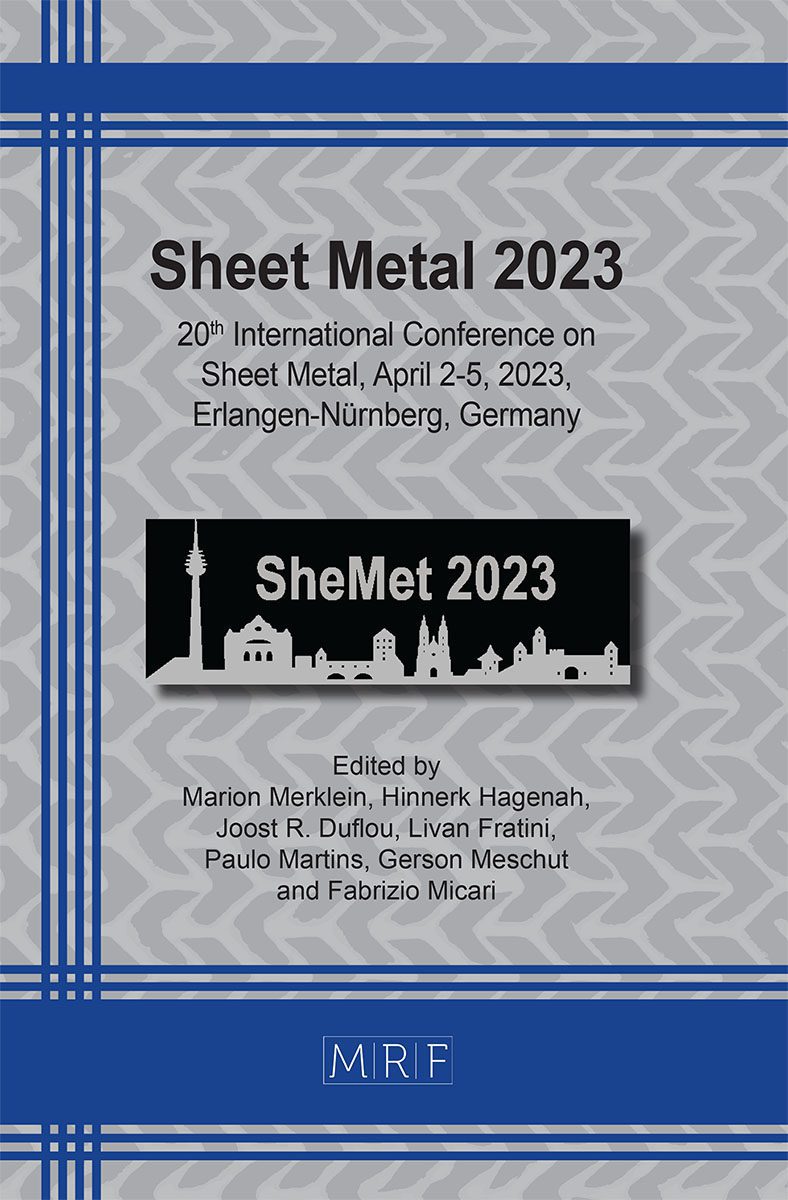Optimization of the sheet hydroforming process parameters to improve the quality of reshaped EoL components
Antonio Piccininni, Angela Cusanno, Giuseppe Ingarao, Gianfranco Palumbo, Livan Fratini
download PDFAbstract. The reshaping of End-of-Life (EoL) components by means of sheet metal forming process has been considered largely attractive, even from the social and economic point of view. At the same time, EoL parts can be often characterized by non-uniform thicknesses or alternation of work-hardened/undeformed zones as the results of the manufacturing process. Such heterogeneity can hinder a proper reshaping of the EoL part and residual marks on the re-formed blanks can be still present at the end of the reshaping step. In a previous analysis, the authors evaluated the effectiveness of reshaping a blank with a deep drawn feature by means of the Sheet Hydroforming (SHF) process: it was demonstrated that residual marks were still present if the deep drawn feature was located in a region not enough strained during the reshaping step. Starting from this condition and adopting a numerical approach, additional investigations were carried out changing the profile of the load applied by the blankholder and the maximum oil pressure. Numerical results were collected in terms of overall strain severity and residual height of the residual marks from the deep drawn feature at the end of the reshaping step. Data were then fitted by accurate Response Surfaces trained by means of interpolant Radial Basis Functions, subsequently used to carry out a virtual optimization managed by a multi-objective genetic algorithm. Optimization results suggested the optimal value of the output variables to reduce the marks from the deep drawn feature without the occurrence of rupture.
Keywords
Aluminium, Hydroforming, Optimization
Published online 3/17/2023, 8 pages
Copyright © 2023 by the author(s)
Published under license by Materials Research Forum LLC., Millersville PA, USA
Citation: Antonio Piccininni, Angela Cusanno, Giuseppe Ingarao, Gianfranco Palumbo, Livan Fratini, Optimization of the sheet hydroforming process parameters to improve the quality of reshaped EoL components, Materials Research Proceedings, Vol. 25, pp 413-420, 2023
DOI: https://doi.org/10.21741/9781644902417-51
The article was published as article 51 of the book Sheet Metal 2023
![]() Content from this work may be used under the terms of the Creative Commons Attribution 3.0 licence. Any further distribution of this work must maintain attribution to the author(s) and the title of the work, journal citation and DOI.
Content from this work may be used under the terms of the Creative Commons Attribution 3.0 licence. Any further distribution of this work must maintain attribution to the author(s) and the title of the work, journal citation and DOI.
References
[1] G. Oberhausen, Y. Zhu, D.R. Cooper, Reducing the environmental impacts of aluminum extrusion, Resour. Conserv. Recycl. 179 (2022) 106120. https://doi.org/10.1016/j.resconrec.2021.106120
[2] M.F. Ashby, Materials and Environment, third ed., Butterworth-Heinemann, Oxford, 2021.
[3] Information on https://www.iea.org/reports/aluminium
[4] T. Tolio, A. Bernard, M. Colledani, S. Kara, G. Seliger, J. Duflou, Design, management and control of demanufacturing and remanufacturing systems, CIRP Ann. 66(2017) 585–609. https://doi.org/10.1016/j.cirp.2017.05.001
[5] D.R. Cooper, J.M. Allwood, Reusing Steel and Aluminum Components at End of Product Life, Environ. Sci. Technol., 46 (2012) 10334–40. https://doi.org/10.1021/es301093a
[6] J.M. Cullen, J.M. Allwood, Mapping the Global Flow of Aluminum: From Liquid Aluminum to End-Use Goods, Environ. Sci. Technol., 47 (2013) 3057–64. https://doi.org/10.1021/es304256s
[7] A. Brosius, M. Hermes, N.B. Khalifa, M. Trompeter, A.E. Tekkaya. Innovation by forming technology: motivation for research, Int. J. Mater. Form., 2 (2009) 29–38. https://doi.org/10.1007/s12289-009-0656-9
[8] H. Takano, K. Kitazawa, T. Goto, Incremental forming of nonuniform sheet metal: Possibility of cold recycling process of sheet metal waste, Int. J. Mach. Tools Manuf., 48 (2008) 477–82. https://doi.org/10.1016/j.ijmachtools.2007.10.009
[9] G. Ingarao, O. Zaheer, D. Campanella, L. Fratini, Re-forming end-of-life components through single point incremental forming, Manuf. Lett., 24 (2020) 132–5. https://doi.org/10.1016/j.mfglet.2020.05.001
[10] G. Ingarao, O. Zaheer, L. Fratini, Manufacturing processes as material and energy efficiency strategies enablers: The case of Single Point Incremental Forming to reshape end-of-life metal components, CIRP J. Manuf. Sci. Technol., 32 (2021) 145–53. https://doi.org/10.1016/j.cirpj.2020.12.003
[11] A. Piccininni, A. Cusanno, G. Palumbo, O. Zaheer, G. Ingarao, L. Fratini, Reshaping End-of-Life components by sheet hydroforming: An experimental and numerical analysis, J. Mater. Process. Technol. 306 (2022) 117650. https://doi.org/10.1016/j.jmatprotec.2022.117650
[12] J. Domitner, Z. Silvayeh, A. Shafiee Sabet, K.I. Öksüz, L. Pelcastre, J. Hardell, Characterization of wear and friction between tool steel and aluminum alloys in sheet forming at room temperature, J. Manuf. Process 64 (2021) 774–84. https://doi.org/10.1016/j.jmapro.2021.02.007
[13] S. Poles, E. Rigoni, T. Robič, MOGA-II Performance on Noisy Optimization Problems. Proc. Int. Conf. Bioinspired. Optim. Methods Their Appl. (2004) 51–62.































